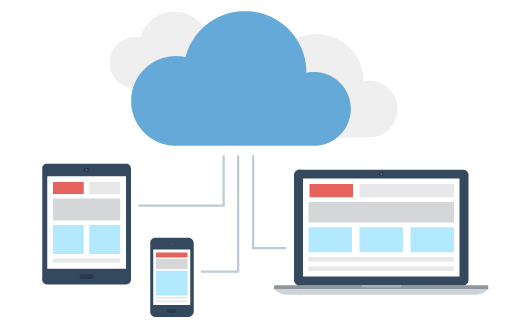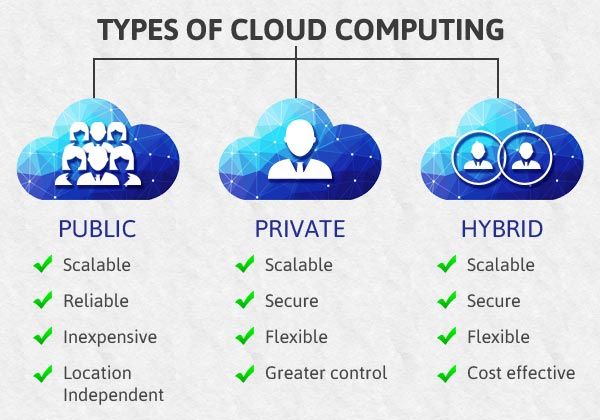Table of Contents

Introduction
The use of cloud computing has exploded in recent years, with businesses and individuals alike seeking ways to store, process and access data remotely. This article provides a comprehensive guide to cloud computing, exploring the basics of cloud services and the various types of cloud computing solutions available.
What is Cloud Computing?
Cloud computing is a technology that allows users to store, process, and access data remotely over the internet. The data is stored on remote servers, known as the “cloud,” rather than on a local computer or server. This means that users can access their data from anywhere with an internet connection, making it easier to work from home or on the go.
Types
Cloud computing has revolutionized the way businesses store, process, and access data. With the ability to access data and applications from anywhere, cloud computing has transformed the way organizations work and operate. But with the vast array of cloud computing options available, it can be overwhelming for beginners to understand the different types of cloud computing and how they can benefit their organization.
In this comprehensive guide, we’ll explore the different types of cloud computing and provide a clear understanding of each one.

- Public Cloud
Public cloud is the most widely used type of cloud computing. In a public cloud, the cloud service provider (CSP) provides a shared pool of resources, such as computing power, storage, and network connectivity, over the internet. The resources are available to the public on a pay-per-use basis.
The main advantage of public cloud is its scalability. Users can quickly add or remove computing resources as needed, without the need for expensive capital expenditures or the hassle of managing hardware. Additionally, public cloud offers lower costs and greater flexibility compared to on-premises solutions.
Some of the most popular public cloud providers include Amazon Web Services (AWS), Microsoft Azure, and Google Cloud Platform.
- Private Cloud
Private cloud is a type of cloud computing that provides dedicated resources, such as computing power, storage, and network connectivity, to a single organization. Private cloud provides greater control and customization compared to public cloud, and is typically more secure.
The main advantage of private cloud is its security. Since private cloud provides dedicated resources, the organization has full control over the security of its data and applications. Additionally, private cloud offers greater customization compared to public cloud, which can be beneficial for organizations that need specific configurations or customizations.
Private cloud can be implemented on-premises or through a third-party provider. Organizations that choose to implement private cloud on-premises typically have existing IT infrastructure and the in-house expertise to manage the cloud. Organizations that choose a third-party provider will typically have a managed service provider (MSP) manage the cloud on their behalf.
- Hybrid Cloud
Hybrid cloud is a type of cloud computing that combines public and private cloud to provide the best of both worlds. Hybrid cloud provides the scalability and cost benefits of public cloud, with the security and control of private cloud.
The main advantage of hybrid cloud is its flexibility. Organizations can choose to run certain workloads in public cloud for cost savings and scalability, and run other workloads in private cloud for security and control. Additionally, hybrid cloud provides the ability to easily move workloads between public and private cloud as needed, providing greater agility and flexibility.
- Community Cloud
Community cloud is a type of cloud computing that provides shared resources to a specific community of organizations with similar needs. Community cloud provides a cost-effective and secure solution for organizations that have similar requirements and can benefit from sharing resources.
The main advantage of community cloud is its cost. By sharing resources, organizations can reduce their costs compared to running their own private cloud. Additionally, community cloud provides increased security compared to public cloud, as the resources are shared among a smaller number of organizations.
- Multi-cloud
Multi-cloud is a type of cloud computing that involves using multiple cloud services from different cloud providers. Multi-cloud provides the ability to mix and match cloud services from different providers to meet specific requirements.
Services

Cloud computing has transformed the way we store, access, and process data, offering businesses and individuals a scalable, flexible, and cost-effective solution. But with so many different cloud computing services available, it can be difficult to know where to start. In this article, we’ll provide an overview of the main types of cloud computing services, helping you to better understand the cloud computing landscape.
Software as a Service (SaaS):
Software as a Service (SaaS) is one of the most popular types of cloud computing services. SaaS allows users to access software applications remotely over the internet, eliminating the need to install software on local computers. Some of the most common SaaS services include email, customer relationship management (CRM), and project management tools.
Benefits of SaaS:
- Accessibility: SaaS allows users to access software applications from anywhere, at any time, as long as they have an internet connection.
- Scalability: SaaS services are highly scalable, making it easy to add or remove users as needed.
- Cost-effectiveness: SaaS services are typically less expensive than traditional software solutions, making them an attractive option for businesses of all sizes.
- Up-to-date software: SaaS services are regularly updated, ensuring that users always have access to the latest software features and functionality.
Platform as a Service (PaaS):
Platform as a Service (PaaS) is a cloud-based platform that provides developers with the infrastructure and tools required to build, test, and deploy web-based applications. PaaS takes care of the underlying infrastructure, freeing up developers to focus on the core aspects of their applications.
Benefits of PaaS:
- Improved efficiency: PaaS allows developers to focus on their core competencies, reducing the time and effort required to develop and deploy applications.
- Scalability: PaaS services are highly scalable, making it easy to add or remove resources as needed.
- Reduced costs: PaaS services are typically less expensive than traditional development environments, reducing the overall cost of developing and deploying applications.
- Access to a wide range of tools and services: PaaS provides developers with access to a wide range of tools and services, including databases, middleware, and other development tools.
Infrastructure as a Service (IaaS):
Infrastructure as a Service (IaaS) is a cloud-based service that provides users with virtualized computing resources, including servers, storage, and network infrastructure. IaaS provides a scalable, flexible solution for businesses that need to manage large amounts of data or complex computing environments.
Benefits of IaaS:
- Scalability: IaaS services are highly scalable, making it easy to add or remove resources as needed.
- Cost-effectiveness: IaaS services are typically less expensive than traditional infrastructure solutions, reducing the overall cost of managing computing environments.
- Flexibility: IaaS services offer a flexible solution, allowing businesses to quickly and easily adjust to changing computing requirements.
Benefits
- Cost Savings
Cloud computing can help businesses save money by reducing the need for expensive hardware and IT infrastructure. By using cloud services, businesses can avoid the upfront costs associated with purchasing and maintaining IT equipment and software.
- Scalability
Cloud computing allows businesses to scale their computing resources up or down as needed, without having to invest in new hardware. This makes it easier for businesses to respond to changing demands and grow as needed.
- Improved Security
Cloud service providers invest heavily in security, offering robust security measures to protect their customers’ data. This makes it easier for businesses to protect their data and ensure that it is secure, even when accessed remotely.
- Increased Collaboration
Cloud computing makes it easier for employees to collaborate and work together, regardless of location. By accessing data and applications from the cloud, employees can work together in real-time and share information more easily.
Conclusion
Cloud computing has revolutionized the way businesses store, process, and access data. With the ability to access data and applications from anywhere, cloud computing has transformed the way organizations work and operate. In this comprehensive guide, we explored the different types of cloud computing, including public cloud, private cloud, hybrid cloud, community cloud, and multi-cloud.
Each type of cloud computing provides unique benefits and is suitable for different organizations based on their specific needs. Public cloud offers scalability and cost savings, while private cloud provides security and control. Hybrid cloud provides the best of both worlds, with the flexibility to move workloads between public and private cloud as needed. Community cloud provides a cost-effective and secure solution for organizations with similar requirements, while multi-cloud provides the flexibility to mix and match cloud services from different providers.
No matter what type of cloud computing your organization chooses, the benefits are clear. Cloud computing provides the ability to store, process, and access data from anywhere, with the scalability, cost savings, and security to meet the needs of any organization. Whether you’re a beginner or an expert in cloud computing, the power of cloud computing is undeniable.
In conclusion, cloud computing is a game-changer for businesses of all sizes. With the ability to store, process, and access data from anywhere, cloud computing provides the flexibility, scalability, and cost savings that organizations need to succeed in today’s digital landscape. If you’re ready to unlock the power of cloud computing, it’s time to start exploring the different types of cloud computing and choose the solution that’s right for your organization.


